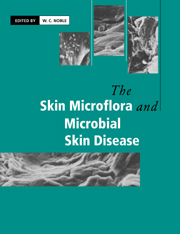Book contents
- Frontmatter
- Contents
- List of contributors
- Preface
- 1 The basis of the skin surface ecosystem
- 2 Nutrition of cutaneous resident microorganisms
- 3 Physical factors affecting the skin flora and skin disease
- 4 Coryneform bacteria
- 5 Coryneforms as pathogens
- 6 Staphylococci on the skin
- 7 Staphylococci as pathogens
- 8 Streptococci and the skin
- 9 Other cutaneous bacteria
- 10 Fungi and fungal infections of the skin
- 11 Bacterial and fungal skin disease in animals
- 12 Viral skin disease in man
- 13 Viral skin disease in animals
- 14 Microbial interactions on skin
- 15 Adherence of skin microorganisms and the development of skin flora from birth
- 16 Skin disinfection
- Index
6 - Staphylococci on the skin
Published online by Cambridge University Press: 04 December 2009
- Frontmatter
- Contents
- List of contributors
- Preface
- 1 The basis of the skin surface ecosystem
- 2 Nutrition of cutaneous resident microorganisms
- 3 Physical factors affecting the skin flora and skin disease
- 4 Coryneform bacteria
- 5 Coryneforms as pathogens
- 6 Staphylococci on the skin
- 7 Staphylococci as pathogens
- 8 Streptococci and the skin
- 9 Other cutaneous bacteria
- 10 Fungi and fungal infections of the skin
- 11 Bacterial and fungal skin disease in animals
- 12 Viral skin disease in man
- 13 Viral skin disease in animals
- 14 Microbial interactions on skin
- 15 Adherence of skin microorganisms and the development of skin flora from birth
- 16 Skin disinfection
- Index
Summary
Taxonomy and typing
The revolution in staphylococcal taxonomy that followed the initial publications of W. E. Kloos and K-H. Schleifer (see below) has led to a much greater appreciation of the ecology of staphylococci on skin but has invalidated much earlier work. There are now 28 species and several subspecies of Staphylococcus (Table 6.1); subdivision within these species is possible on phenotypic or genotypic grounds and the chemistry underlying the taxonomy has been well explored. The principal habitat of staphylococci is the skin and some mucous membranes of mammals and birds, though few birds and virtually no non-mammalian animals have been studied.
Staphylococci are generally aerobic, Gram-positive cocci, which appear in irregular, so-called grape-like clusters under the microscope, although single and paired cells are the most common in fluid culture. They are catalase positive, have a mol per cent G + C of 30–37, possess teichoic acid in the cell wall and have glycine in the interpeptide bridge of peptidoglycan, lack cytochromes c and d, and have MK6–8 as the major menaquinones. This serves to separate the staphylococci from micrococci with which they were formerly linked, as Micrococcus spp. have a mol per cent G + C of 66–75, lack teichoic acid and glycine, possess cytochrome c and d, and have MK7(H2)–9(H2) as major quinones. Micrococcus and Staphylococcus are now regarded as very distinct genera.
- Type
- Chapter
- Information
- The Skin Microflora and Microbial Skin Disease , pp. 135 - 152Publisher: Cambridge University PressPrint publication year: 1993
- 6
- Cited by



